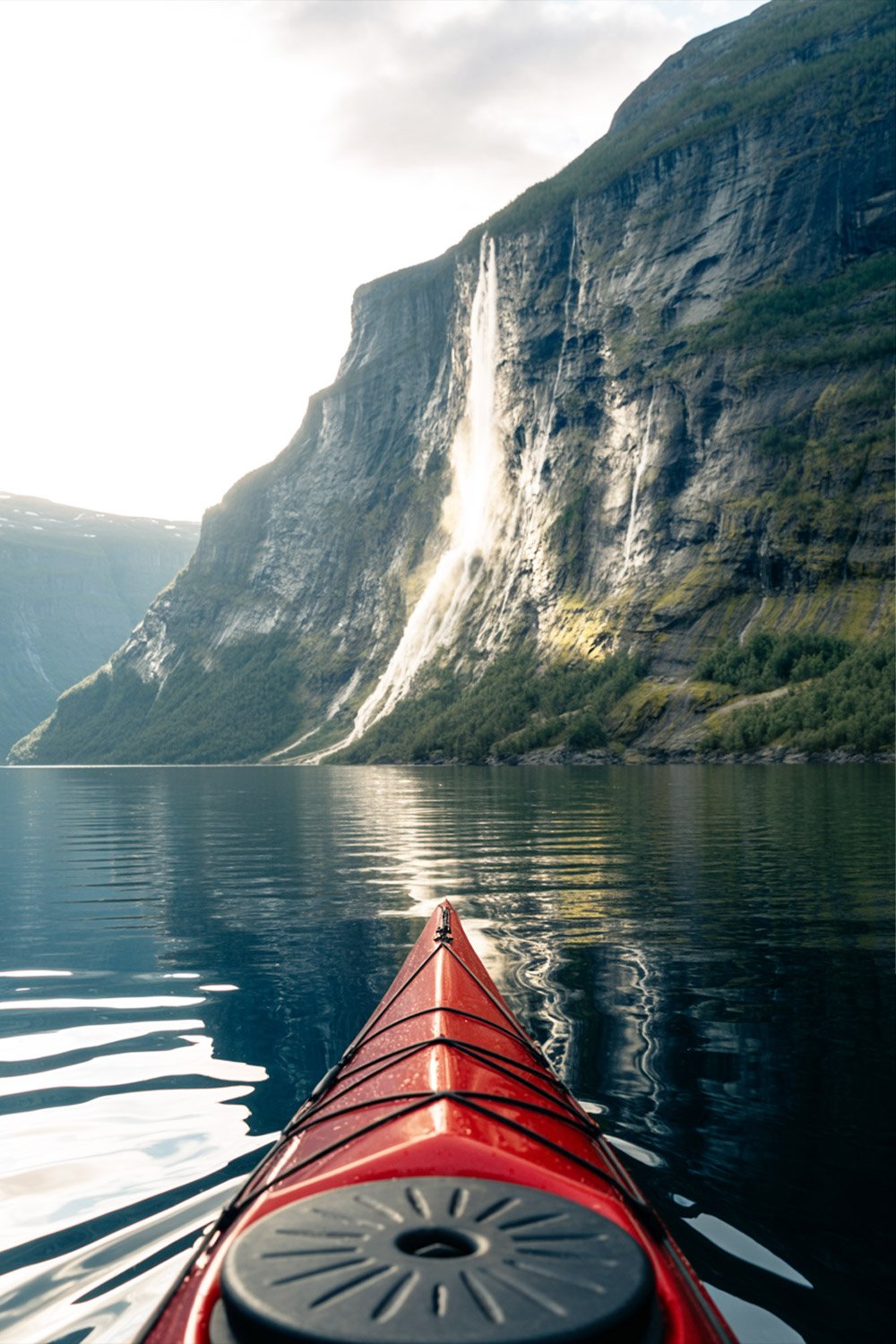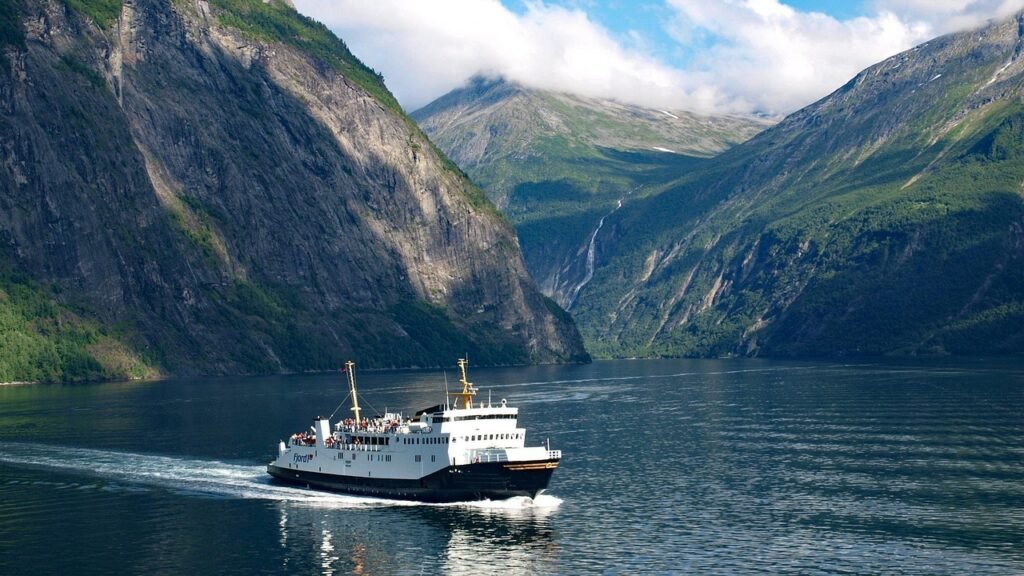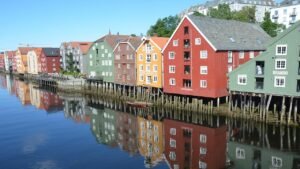Estimated reading time: 15 minutes
Key Takeaways
- The Flåm Railway offers one of the world’s steepest and most scenic train journeys with panoramic mountain views
- UNESCO-protected Nærøyfjord and Geirangerfjord provide the most spectacular fjord experiences in Norway
- The Seven Sisters Waterfall and Dalsnibba Mountain Plateau are must-visit natural landmarks when touring Norwegian fjords
- Combining rail, boat, and bus travel creates the most comprehensive fjord tour experience
- The best time to visit Norwegian fjords is May through September for optimal weather and accessibility
Table of Contents
- Introduction
- Norway’s Fjords and Scenic Journeys
- The Flåm Railway Scenic Journey
- Nærøyfjord – A UNESCO Jewel on Water
- What to Do in Geirangerfjord
- Iconic Natural Landmarks – Seven Sisters Waterfall and Dalsnibba
- Best Fjord Tours in Norway
- Conclusion
Introduction
Norway stands as a land of breathtaking natural wonders, where dramatic fjords cut deep into the landscape, towering peaks reach for the sky, and cascading waterfalls thunder down sheer cliff faces. This Nordic treasure offers visitors a unique blend of pristine nature and rich cultural heritage that few destinations can match. In this guide, we focus on experiencing Norway’s iconic fjords and scenic journeys, highlighting must-see attractions including the famous Flåm Railway scenic journey and the best fjord tours in Norway that showcase these geological marvels at their finest.
Want to see this for yourself? Click here to watch the video from this point.
Norway’s Fjords and Scenic Journeys
Norwegian fjords are glacially formed inlets characterized by their narrow passages, steep cliff walls, and remarkably deep waters. These natural wonders were carved over millions of years as massive glaciers slowly retreated, leaving behind these distinctive U-shaped valleys that eventually filled with seawater. [SOURCE]
What makes Norway’s fjords truly special is their dramatic scale and beauty. Many feature vertical cliff faces rising more than 1,000 meters directly from the water, creating some of the most awe-inspiring landscapes on earth. Their pristine waters reflect the surrounding mountains, creating a mirror-like effect that photographers and nature lovers travel thousands of miles to witness.
Key Attractions Along Norway’s Fjords
Scenic Train Rides: The Flåm Railway (Flåmsbana) stands as one of the world’s most famous train journeys, recognized globally for its engineering marvel and breathtaking vistas. This remarkable railway climbs 866 meters over just 20 kilometers, making it one of the steepest standard-gauge railways in the world. [SOURCE]
Boat Tours: Cruising through fjords like Nærøyfjord and Geirangerfjord offers visitors an intimate perspective of these natural wonders. From the water, you can fully appreciate the towering scale of the surrounding cliffs and watch as waterfalls cascade directly into the fjord. [SOURCE]
Panoramic Views: Mountain viewpoints such as Dalsnibba provide spectacular aerial perspectives of the fjord landscapes below. Standing at these elevated positions helps visitors grasp the true magnitude and beauty of Norway’s fjord system. [SOURCE]
These natural treasures have earned two of Norway’s fjords—Nærøyfjord and Geirangerfjord—spots on the UNESCO World Heritage list, recognizing their exceptional natural beauty and geological significance. Visitors to Norway’s top travel destinations consistently rank fjord experiences among their most memorable activities.
The Flåm Railway Scenic Journey
The Flåm Railway (Flåmsbana) represents one of the world’s most remarkable engineering achievements in railway construction. This 20-kilometer journey connects the mountain station of Myrdal with the small village of Flåm at the inner end of the Aurlandsfjord. What makes this railway truly extraordinary is its gradient—it’s one of the steepest standard-gauge railways globally, with an impressive 5.5% incline through much of its route. [SOURCE]
Construction of the railway began in 1923 and took 20 years to complete, with much of the work done by hand. The line features 20 tunnels, with 18 of them excavated manually—a testament to the incredible human effort behind this engineering marvel.
Scenic Features Along the Flåm Railway
Waterfalls: The most famous stop along the Flåm Railway is at Kjosfossen waterfall, where the train pauses for passengers to disembark and witness the powerful cascade up close. During tourist season, visitors might catch a glimpse of a dancer portraying the mythical “Huldra”—a forest spirit from Norwegian folklore—performing by the waterfall. [SOURCE]
Valleys and Mountains: Throughout the journey, passengers witness dramatic transitions in the landscape as the train winds through the narrow Flåm Valley. The scenery shifts from snow-capped mountains and barren highlands at Myrdal to the lush, green valley floor approaching Flåm. Sharp curves in the track offer continually changing perspectives of the surrounding mountains. [SOURCE]
Nearby Attractions and Activities
The Flåm Railway is more than just a transport route—it’s the centerpiece of a comprehensive visitor experience. Once in Flåm, travelers can extend their adventure with several complementary activities:
- Flåm Zipline: Norway’s longest zipline offers an adrenaline-fueled perspective of the valley
- Hiking: Well-marked trails lead to panoramic viewpoints overlooking the fjord
- Cycling: The famous Rallarvegen (Navvies’ Road) offers a scenic cycling route originally built to service the railway
- Fjord Cruising: Boat tours from Flåm connect visitors to the UNESCO-listed Nærøyfjord [SOURCE]
The Flåm Railway experience can be enjoyed year-round, though each season offers distinct charms—from snow-draped winter landscapes to vibrant summer greenery. Many visitors incorporate this iconic journey into the popular “Norway in a Nutshell” tour, which combines the Flåm Railway with other scenic transportation routes.
Nærøyfjord – A UNESCO Jewel on Water
The Nærøyfjord stands as one of Norway’s most spectacular natural treasures, earning its place on the UNESCO World Heritage list alongside the Geirangerfjord in 2005. At just 250 meters wide at its narrowest point and surrounded by mountains reaching 1,800 meters high, this 17-kilometer branch of the larger Sognefjord creates an intimate, almost otherworldly landscape that leaves visitors in awe. [SOURCE]
UNESCO Designation and Geological Significance
The UNESCO World Heritage designation recognizes the Nærøyfjord not only for its exceptional beauty but also for its geological and ecological importance. This fjord represents a textbook example of classic fjord formation, displaying the interaction between natural forces—glaciers, rivers, and tectonic activity—that have shaped this landscape over millions of years.
The steep mountain walls, some nearly vertical, showcase visible layers of rock that tell the story of Norway’s geological past. The pristine water quality and relative isolation have preserved unique marine and terrestrial ecosystems that scientists continue to study today. [SOURCE]
Nærøyfjord UNESCO Boat Tour Experience
A boat tour through the Nærøyfjord offers what many consider the definitive Norwegian fjord experience. As vessels navigate the narrow waterway, passengers enjoy unparalleled views of:
- Dramatic cliff faces that rise almost vertically from the water’s surface
- Cascading waterfalls that vary in intensity with the seasons—particularly impressive during spring snowmelt
- Tiny villages like Undredal and Dyrdal that seem to cling precariously to the mountainsides
- Wild goats and other wildlife that inhabit the steep slopes
The boat journey typically runs between the villages of Gudvangen and Flåm, taking approximately two hours to navigate the stunning landscapes. Both traditional ferries and smaller, environmentally friendly electric vessels operate on this route, giving visitors options based on their preferences. [SOURCE]
Practical Tips for Nærøyfjord Visits
To make the most of your Nærøyfjord UNESCO boat tour experience:
- Consider visiting during shoulder seasons (May or September) when tourist numbers are lower but weather remains favorable
- Book the first morning departure for the calmest water conditions and best light for photography
- Position yourself on the open deck for unobstructed views, but bring warm layers as the fjord can be cool even in summer
- If possible, experience the fjord from both water level and elevation by combining a boat tour with hiking the Rimstigen trail or visiting the Stegastein viewpoint [SOURCE]
The Nærøyfjord consistently ranks among the most awe-inspiring natural attractions in Scandinavia and represents an essential experience for anyone seeking to understand Norway’s unique landscape heritage, as highlighted in this Scandinavia fjords documentary.
What to Do in Geirangerfjord

Geirangerfjord, like its UNESCO World Heritage partner Nærøyfjord, offers visitors a sublime natural experience that showcases Norway at its most dramatic. This S-shaped, 15-kilometer long fjord is surrounded by some of the steepest mountains in western Norway, creating a landscape that has inspired artists, photographers, and travelers for generations. [SOURCE]
Understanding Geirangerfjord’s Unique Character
What sets Geirangerfjord apart is not just its physical beauty but also the rich cultural landscape that has developed around it. For centuries, hardy Norwegians established farms on the seemingly inaccessible mountain ledges overlooking the fjord. These historic farmsteads—some accessible only by ladders or narrow paths—tell a compelling story of human adaptation to challenging environments.
The fjord’s physical characteristics create a microclimate that supports diverse plant and animal life, while its deep, clear waters serve as a habitat for numerous marine species. The combination of natural and cultural elements earned Geirangerfjord its UNESCO status and makes it a multi-faceted destination for visitors. [SOURCE]
Essential Geirangerfjord Activities
When visiting Geirangerfjord, these experiences should top your activity list:
- Fjord Cruising: The classic way to experience Geirangerfjord is from the water. Sightseeing boats depart regularly from Geiranger village, offering various tour lengths. These cruises provide optimal views of famous waterfalls and abandoned fjord farms. [SOURCE]
- Hiking: The mountains surrounding Geirangerfjord feature numerous well-marked trails for all ability levels. Popular routes include:
- Skageflå Farm Trail – A challenging hike to one of the best-preserved fjord farms
- Storseterfossen Waterfall – A trail that actually leads behind the waterfall
- Vesterås Farm – Offering several trail options with excellent viewpoints
- Kayaking: For a more intimate fjord experience, guided kayak tours allow you to paddle at your own pace, accessing shallow areas larger vessels can’t reach while connecting directly with the water and surroundings.
- Cultural Exploration: Visit the Norwegian Fjord Center in Geiranger to learn about the area’s geology, history, and the lives of those who farmed the steep mountainsides for centuries.
The small village of Geiranger serves as the main hub for visitors, offering accommodations ranging from campgrounds to luxury hotels. Despite its small size (with only about 250 permanent residents), the village provides all necessary services for travelers during the tourism season, which runs primarily from May to September.
Iconic Natural Landmarks – Seven Sisters Waterfall and Dalsnibba Mountain Plateau View
Among Norway’s many natural wonders, certain landmarks stand as defining features of the fjord landscape. Two of the most spectacular are the Seven Sisters Waterfall and the Dalsnibba Mountain Plateau, both offering visitors unforgettable visual experiences that capture the essence of Norway’s dramatic terrain.
Seven Sisters Waterfall Norway
The Seven Sisters Waterfall (De Syv Søstrene) is perhaps the most photographed waterfall in all of Norway, cascading down the eastern wall of Geirangerfjord. As its name suggests, the waterfall consists of seven separate streams flowing side by side, creating a veil-like effect as they plunge approximately 250 meters from the mountain plateau into the fjord below. [SOURCE]
Norwegian folklore adds a charming dimension to this natural spectacle. According to local legend, the seven streams represent seven sisters dancing down the mountainside, while directly across the fjord, another waterfall called “The Suitor” tries unsuccessfully to court them. This anthropomorphic storytelling reflects Norwegians’ traditional connection to their natural surroundings.
The waterfall is most impressive during late spring and early summer when snowmelt increases water volume. Fjord cruises typically slow down or pause when passing the Seven Sisters to allow passengers optimal viewing and photography opportunities.
Dalsnibba Mountain Plateau View
Rising 1,476 meters above sea level, the Dalsnibba Mountain Plateau offers what many consider the ultimate panoramic vista of the Norwegian fjord landscape. This accessible mountain viewpoint provides visitors with a bird’s-eye perspective of Geirangerfjord and the surrounding mountain ranges, creating a sense of scale difficult to comprehend from water level. [SOURCE]
The viewing area, known as Geiranger Skywalk, features a modern platform with glass safety barriers that allow for unobstructed views while ensuring visitor safety. On clear days, the visibility extends far beyond Geirangerfjord to encompass snow-capped mountains and distant valleys.
Practical information for visiting Dalsnibba:
- Accessible via the toll road Nibbevegen from Geiranger village (approximately 45 minutes by car)
- Open seasonally from late May to October (weather dependent)
- Morning visits often offer the clearest visibility before afternoon clouds develop
- Weather conditions can change rapidly; check forecasts before ascending
- Bring warm clothing as temperatures at elevation can be significantly cooler than in the valley
Together, the Seven Sisters Waterfall and Dalsnibba Mountain Plateau provide complementary perspectives of Geirangerfjord—one from water level looking up at the vertical dimension of the landscape, and the other from above, appreciating the horizontal expanse of the fjord system. Including both in your itinerary delivers a complete understanding of Norway’s fjord geography.
Best Fjord Tours in Norway
Norway offers a rich variety of fjord tour options catering to different preferences, timeframes, and adventure levels. The best fjord tours in Norway typically combine multiple transportation modes and natural highlights to create comprehensive experiences. Here’s a summary of top tour options and how to choose the right one for your needs.
Tour Summary: Top Fjord Experiences
1. Norway in a Nutshell: Perhaps the most famous and well-established tour package, this flexible itinerary combines the Bergen Railway, the Flåm Railway scenic journey, and a cruise on the Nærøyfjord. It can be completed in one intensive day or spread over several days with overnight stops in picturesque villages like Flåm or Balestrand. [SOURCE]
2. Geirangerfjord Complete: This tour focuses on the UNESCO-listed Geirangerfjord and typically includes a fjord cruise, visits to the Seven Sisters Waterfall, and access to panoramic viewpoints like Dalsnibba Mountain Plateau and Eagle Road. The village of Geiranger serves as the hub for these activities.
3. Hardangerfjord Tour: Less crowded than some other fjord destinations but equally beautiful, Hardangerfjord tours often feature the fruit orchards along its shores (spectacular during spring blossom season), historic sites, and the impressive Vøringsfossen waterfall.
4. Sognefjord Explorer: Centered around Norway’s longest and deepest fjord, these tours may include visits to the Nærøyfjord (a branch of the Sognefjord), the Stegastein Viewpoint, and cultural sites like the Urnes Stave Church, another UNESCO World Heritage site.
Choosing the Right Tour for Your Interests
When selecting among the best fjord tours in Norway, consider these factors to match tours with your personal preferences:
- For adventure seekers: Look for tours that incorporate active elements like hiking, kayaking, or cycling alongside the standard transportation options. The Flåm area offers excellent opportunities to combine railway journeys with active pursuits. [SOURCE]
- For photography enthusiasts: Prioritize tours with stops at key viewpoints and those that visit fjords during optimal lighting conditions. Early morning or late afternoon departures often provide the most dramatic lighting for photography.
- For cultural exploration: Choose tours that include visits to historic farms, traditional villages, and museums that explain the human history of the fjord regions.
- For luxury travelers: Several operators offer premium fjord experiences with upscale accommodations, gourmet dining featuring local ingredients, and private guides who can customize the experience.
Suggested Itineraries for Comprehensive Experiences
For those seeking to create the ultimate fjord journey, consider these multi-day itineraries that combine the best elements of Norway’s fjord landscape:
5-Day Fjord Highlights:
- Day 1: Oslo to Bergen via the scenic Bergen Railway
- Day 2: Bergen to Flåm, including the Flåm Railway scenic journey
- Day 3: Nærøyfjord UNESCO boat tour and overnight in a fjordside village
- Day 4: Transfer to Geiranger with stops at panoramic viewpoints
- Day 5: Geirangerfjord cruise and visit to the Seven Sisters Waterfall
Adventure-Focused Itinerary:
- Combine the Flåm Railway with hiking or cycling the Rallarvegen (Navvies Road)
- Add kayaking on the Nærøyfjord for water-level perspectives
- Include hiking to abandoned fjord farms above Geirangerfjord
- Consider RIB boat experiences for faster, more dynamic fjord exploration [SOURCE]
Most fjord tours operate from May through September when weather conditions are most favorable. However, each season offers distinct advantages: spring brings rushing waterfalls and flowering fruit trees, summer offers long daylight hours for extended exploration, and early autumn brings vibrant foliage colors and fewer crowds.
Conclusion
Norway’s fjords represent some of the world’s most spectacular natural landscapes, offering visitors experiences that combine geological wonders, cultural heritage, and outdoor adventure. From the engineering marvel of the Flåm Railway scenic journey to the pristine waters of UNESCO-protected Nærøyfjord and Geirangerfjord, these destinations showcase nature at its most dramatic and awe-inspiring.
The best fjord tours in Norway cater to every travel style—whether you seek peaceful contemplation of beautiful vistas, active adventures amid stunning scenery, or deeper cultural connections to the communities that have called these challenging landscapes home for centuries. By combining different transportation modes and perspectives—from mountain viewpoints to water-level cruises—visitors gain a comprehensive understanding of these unique natural formations.
The Norwegian fjord landscape tells a story of geological forces, human adaptation, and the careful balance between development and preservation. As recognized by UNESCO and countless travelers, these fjords represent natural heritage of exceptional value that deserves both our admiration and protection.
As you plan your Norwegian adventure, consider how different fjord experiences might complement each other—perhaps pairing the intimate narrow passages of Nærøyfjord with the grander scale of Geirangerfjord, or contrasting the mountain perspectives from the Flåm Railway with the water-level views from a traditional fjord cruise.
Whether you choose a comprehensive multi-day tour or focus intensively on a single fjord region, the natural majesty of Norway’s fjord landscape promises memories that will last a lifetime. Now is the perfect time to begin planning your journey into the heart of these magnificent natural wonders.
For more stunning views of Norway’s breathtaking landscapes, visit Pathfinders Travel on YouTube to watch Wonders of the World Travel Documentaries in 4K resolution.


